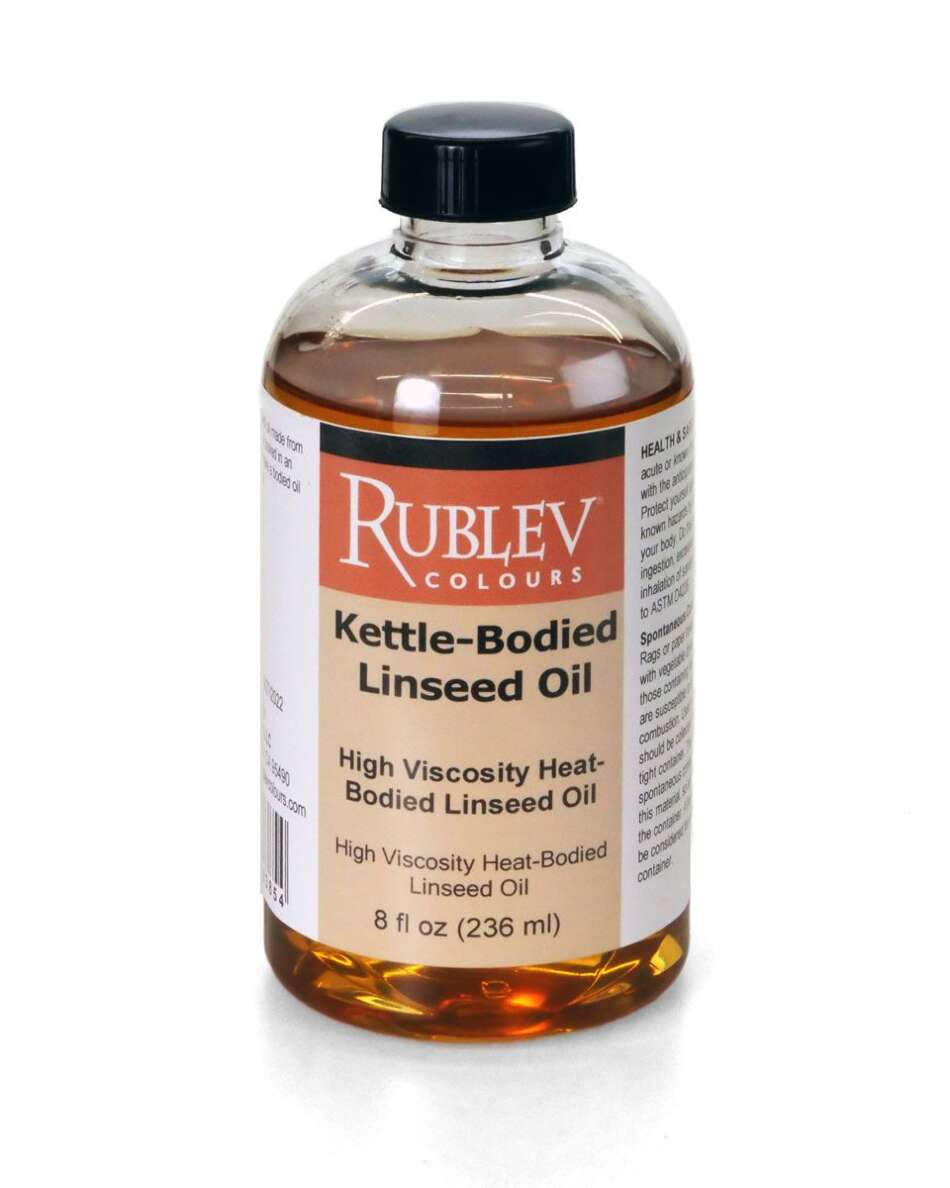Kettle-Bodied Oil High Viscosity 8 fl oz
$17.60
In stock
SKU
510-41OSU08
This heat-bodied oil is made from well-refined linseed oil from North American flax seeds that is cooked in closed kettles to make a stand oil of medium acid range. The color is better than oils obtained by conventional open-kettle cooking. 8 oz (237 ml)
Stand oil is heat treated and polymerized (thickened) oil. This heat-bodied oil is made from well-refined linseed oil from American flax seeds that is cooked in closed kettles to make a bodied oil of medium acid range. The color is better than oils obtained by conventional open-kettle cooking, yet darker than vacuum-bodied oils.
The term "stand oil" derived from the Dutch word that designated drying oil that had been heat treated and aged by standing. Later it applied to oils that were bodied by heat treated for prolonged periods in open kettles. Stand oil, invented in the 19th century, replaced Venice turpentine and sun-thickened linseed oil in painting mediums. Stand oil leaves an enamel-like finish to paint. Bodied oils form harder films than refined or raw linseed oils. The use of the term "stand oil" is antiquated since bodied oils today are processed differently than those in the 19th century.
Adding large amounts of stand oil or bodied oil increases the tendency of oil paintings to wrinkle (alligator). Adding 10% by volume of bodied oil to alkyd painting mediums increases the viscosity of the alkyd medium and slows down the drying time.
Use turpentine or mineral spirits as the solvent for bodied oils and for brush and studio clean up.
Linseed oil is a yellowish drying oil derived from the dried ripe seeds of the flax plant (Linum usitatissimum, Linaceae).
Warning: Rags or paper towels contaminated with vegetable drying oils, particularly those containing iron oxide pigments are susceptible to spontaneous combustion. To prevent unexpected fires, used rags or paper towels contaminated with oil-based materials should be collected in a closeable, air-tight container. Store water-dampened rags or paper towels in a metal container with an air-tight top. Alternately, washing contaminated rags will remove contaminating materials and eliminate risk.
The term "stand oil" derived from the Dutch word that designated drying oil that had been heat treated and aged by standing. Later it applied to oils that were bodied by heat treated for prolonged periods in open kettles. Stand oil, invented in the 19th century, replaced Venice turpentine and sun-thickened linseed oil in painting mediums. Stand oil leaves an enamel-like finish to paint. Bodied oils form harder films than refined or raw linseed oils. The use of the term "stand oil" is antiquated since bodied oils today are processed differently than those in the 19th century.
Adding large amounts of stand oil or bodied oil increases the tendency of oil paintings to wrinkle (alligator). Adding 10% by volume of bodied oil to alkyd painting mediums increases the viscosity of the alkyd medium and slows down the drying time.
Use turpentine or mineral spirits as the solvent for bodied oils and for brush and studio clean up.
Linseed oil is a yellowish drying oil derived from the dried ripe seeds of the flax plant (Linum usitatissimum, Linaceae).
Warning: Rags or paper towels contaminated with vegetable drying oils, particularly those containing iron oxide pigments are susceptible to spontaneous combustion. To prevent unexpected fires, used rags or paper towels contaminated with oil-based materials should be collected in a closeable, air-tight container. Store water-dampened rags or paper towels in a metal container with an air-tight top. Alternately, washing contaminated rags will remove contaminating materials and eliminate risk.
| SKU | 510-41OSU08 |
|---|---|
| Brand | Rublev Colours |
| Vendor | Natural Pigments |
| Processing Time | Usually ships the next business day. |
| Size | 8 fl oz (236.5 ml) |



